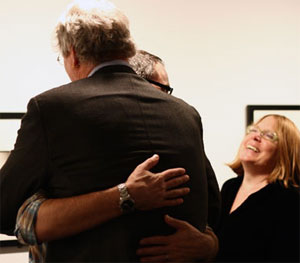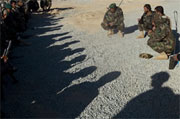 |
| Craig J. Barber, "Hope Is All There Was," 1997. |
Award-winning photojournalist Louie Palu, whose photographic collection Zhari-Panjwai: Dispatches from Afghanistan is on display at the Dalhousie Art Gallery, resides in Washington, DC. The weather in Washington, he says, is stiflingly hot. The fact that the American heat bothers him at all comes as a surprise. Mr. Palu just spent three months in Afghanistan, and he will return to the war-torn country in two weeks. Surely the weather there will be much warmer?
“It’ll be a hundred degrees,” Mr. Palu agrees. “It’ll be really, really hot… hot and dry and brutal. It’s an extremely unforgiving landscape… Canadians are almost suited to it,” he adds – in terms not of warmth, but sheer extremity of temperature.
Afghanistan’s weather is not its most dangerous feature. “With the troops, I was received very well,” Mr. Palu says. “(Other) people shot at me. I would say they were people who did not receive me as well.” He discusses his close shaves with surreal cool. “I’m not the only journalist to ever get shot at… If there were 20 Taliban, and one was a journalist, and a firefight started… I don’t think anyone would say, ‘Hey, that guy’s a journalist. Don’t shoot him.’”
What are some of these elusive pieces? “Different tribes, different languages, money, road-building… there’s not even one road that connects the whole country.” Mr. Palu’s photographs are displayed with an accompanying audio track of battle in Siah Choi. Between gunshots on the track, people yell, gasping breaths, speaking – in different languages – the lingua franca of fear.
Craig Barber was an 18-year-old Marine when he first stepped on Vietnamese soil. He returned to Vietnam as a photographer, in 1995—30 years later. “My return allowed me to understand who I was, and appreciate who I have become,” he says. “I was able to learn many aspects about the Vietnamese people… that I knew nothing of while there (previously). It was an incredibly cathartic experience.” Mr. Barber has platinum-printed his suite of pinhole photographs. Invented in 1873, platinum-printing—uncommon in modern photography—produces images which are extraordinarily long-lasting.
His photographs are cryptically named – in “The Old Man Served Tea” (1997), for instance, there is no old man and no tea. “My titles usually reflect what was happening at the moment of the photo,” says Mr. Barber, “but also speak to memories of my time there during the war.”
 |
| Craig Barber embraces Louie Palu, as curator Alison Devine Nordstrom looks on. (Bruce Bottomley Photo) |
The human figures in Mr. Barber’s work are ghostlike, blurred (“Always Curious” 1995) or double-exposed (The Gatherers” 1998) into transparency. “With colour, you state, and with black and white, you suggest,” he says. “I feel my work leaves more to the imagination than it would if it were in colour… I appreciate my audience’s intelligence, and anticipate their bringing that intelligence into the gallery and their desire to understand the mood of my work.” His Vietnam is a Pacific dreamscape, radiating a tropical beauty shattered by broken village kilns (“The Kilns of Vinh Long” 1998) and abandoned hotels (“Sapa Hotel” 1997).
Craig Barber’s collection from Vietnam, in contrast with the immediacy of Mr. Palu’s work, is black-and-white, ethereal, and haunting. Yet what the two collections document is similar: the wars in Vietnam and Afghanistan have much in common. “Each fought against a determined insurgency, each destroying the lives of a young generation on both sides of the conflict,” says Mr. Barber, “and each fought against a culture and a people that we do not understand or are attempting to understand… Wars are brutal. Vietnam was, Afghanistan is, you name it… War is just not pleasant.”
“I’m not so much dealing with a message… as with documenting reality,” says Mr. Palu. “I’m not trying to show exactly the way Afghanistan is… War for me is all in one box. When someone is shot and dying in front of you, it’s pretty much the same thing.”
LINK: Dalhousie Art Gallery

